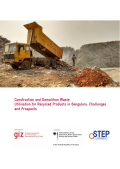
India is currently one of the fastest-growing economies in the world and the construction industry alone accounted for approximately 10% of its GDP in 2014. The Central Pollution Control Board (CPCB) classifies waste generated from the Construction and Demolition (C&D) of buildings and civil infrastructure as construction and demolition waste (CDW). The CPCB has estimated solid waste generation in India to be around 48 million tonnes per annum of which the construction industry accounts for approximately 25%. However, this estimate of 12-15 million tonnes of CDW is widely considered dated and a significant underestimate; but no updated comprehensive estimate for the country exists. In India, although some valuables are recovered from CDW and some of it is used for filling, most of it gets disposed in landfills or through unauthorised dumping in low-lying areas, open spaces, roadsides or water bodies creating enormous nuisance and environmental problems. India requires a paradigm shift from a dumping based approach to utilising CDW efficiently.

In June 2014 the Government of India launched the Power for All initiative with an aim to provide 24x7 power across the country by 2019. Subsequently, a sub-committee of the Forum of Regulators (FoR) prepared a national roadmap for the initiative. FoR defined the scope of the initiative to include reliable 24x7 power supply to domestic, industrial, and commercial consumers, power supply to irrigation pump sets for 8 to 10 hours, and access to all connected households by 2018–19. The roadmap made recommendations for fuel supply, generation, transmission and distribution sectors, and demand-side management. In view of the federal structure of India’s power sector, a key recommendation of the FoR study was to formulate state-level strategies to meet the objectives of 24x7 Power for All.
This technical analysis for the Nordic Green to Scale report was commissioned to CICERO (Center for International Climate and Environmental Research – Oslo), which is Norway’s foremost institute for interdisciplinary climate research. The report illustrates the scaling potential of 15 proven Nordic low-carbon solutions and presents an analysis of the greenhouse gas emissions reductions of these solutions and their scalability internationally.
The Urban Green Growth in Dynamic Asia project explores how to promote green growth in cities in Asia, examining policies and governance practices that encourage environmental sustainability and competitiveness in a rapidly expanding economy. This synthesis report presents the results of case studies along with practical policy recommendations, reflecting the local contexts of Southeast Asia. While Southeast Asian cities are affected by a range of economic, infrastructure, environmental and social challenges, ongoing rapid development offers opportunities to shift towards greener growth models. The concept of urban green growth can be a powerful vector of sustainable development, by emphasising the existence and potential of co-benefits between economic and environmental performance.
Africa stands at the threshold of a tremendous opportunity: its economies are seeking to shift to higher productivity sectors which can boost prosperity and drive developmental goals. At the same time, the right kind of economic transformation can also ensure that Africa’s growth is sustainable and resilient in the face of the increasing impacts of climate change.
This report offers key insights for policy makers seeking to deliver better growth and a better climate in African countries. It aims to help decision-makers take stock of the region’s recent experiences and draw lessons for the future. In particular, it seeks to crystallise ideas on how to harness the forces of economic, social and environmental change to accelerate inclusive and sustainable development across the region.
For Africa to achieve this better growth, the report identifies five action areas for governments to consider as they formulate development strategies and action plans for the future. These are:
